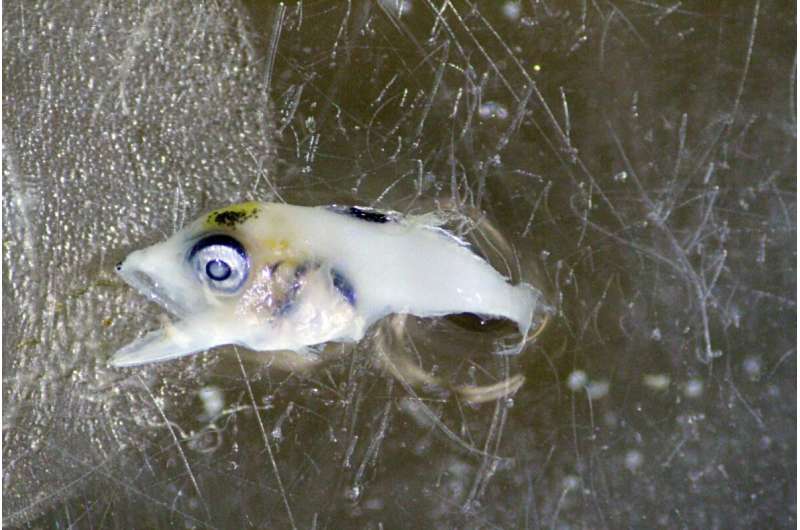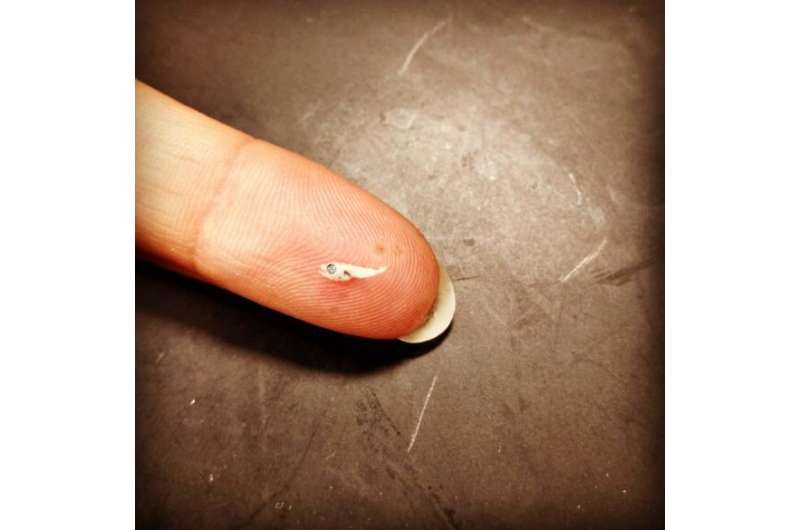Bluefin tuna are the largest of all tuna species – adults can reach ten feet in length and weigh more than a thousand pounds. But they start out small, as 2- to 3-millimeter-long larvae. This one was caught by Chrissy Hernandez in the Slope Sea, a region of the Atlantic Ocean between the between the U.S. continental shelf and the Gulf Stream farther offshore. The area is a newly-recognized spawning ground for western Atlantic bluefin tuna – more good news for a species whose population in the Gulf of Mexico is sustainably managed with a limited harvest. Credit: Chrissy Hernandez, Woods Hole Oceanographic Institution
The Slope Sea off the Northeast United States is a major spawning ground for Atlantic bluefin tuna (Thunnus thynnus), a new paper affirms. This finding likely has important implications for population dynamics and the survival of this fish, according to the paper, "Support for the Slope Sea as a major spawning ground for Atlantic bluefin tuna: evidence from larval abundance, growth rates, and particle-tracking simulations," published in the Canadian Journal of Fisheries and Aquatic Sciences.
"Overall, our results provide important supporting evidence that the Slope Sea is a major spawning ground that is likely to be important for population dynamics," the paper states. Spawning in the Slope Sea "may offer the species additional resilience in the face of both harvesting and climate change," the paper adds.
The paper presents larval evidence supporting the recognition of the Slope Sea as a major spawning ground, including that larvae collected in the Slope Sea grew at the same rate as larvae collected in the Gulf of Mexico, indicating that this region is good larval habitat.
"In comparison to everything else we know about this species, the Slope Sea is a perfectly good place to be born as a larva," said lead author Christina Hernández, who was a doctoral student in the Massachusetts Institute of Technology (MIT) - Woods Hole Oceanographic Institution (WHOI) Joint Program in Oceanography/Applied Ocean Science and Engineering at the time of the study.
"The larvae are growing at a similar rate in the Slope Sea as they are in the Gulf of Mexico, at least in the year [of sampling], which suggests that the Slope Sea is providing completely suitable and adequate habitat for larval growth and development," she said.
The researchers used plankton nets to collect larvae in the Slope Sea and the Gulf of Mexico, and they analyzed and compared larval growth in the two regions by studying larval otoliths, which are small bones found in the heads of tuna. Researchers also conducted larval transport simulations to estimate the movement of larvae floating in ocean currents forward and backward in time to evaluate the origin of the larvae and their fate.
Bluefin tuna larvae are 2 to 3 millimeters long when they hatch, but they can grow quickly, adding roughly 0.5 millimeter per day. Credit: Chrissy Hernandez, Woods Hole Oceanographic Institution
The prevailing understanding has been that Atlantic bluefin tuna comprise two populations with strong natal homing to spawning grounds in the Gulf of Mexico and the Mediterranean Sea. However, there has long been speculation that spawning may occur in other regions, and a 2016 paper demonstrated a bluefin tuna spawning ground in the Slope Sea. The Slope Sea is a wedge of ocean that is bounded by the U.S. shelf break and the Gulf Stream as it moves away from the U.S. east coast.
"In the 2016 paper, we proposed that the Slope Sea is a third major spawning ground for bluefin tuna. The additional sampling, reported in this new paper, confirmed that bluefin larval abundances in the Slope Sea are comparable to levels typically found in the Gulf of Mexico. Moreover, bluefin tuna larvae in the Slope Sea were found to grow at similar rates to those in the Gulf of Mexico," said David Richardson, research fisheries biologist with the National Oceanic and Atmospheric Administration (NOAA). Richardson is the lead author of the 2016 paper and co-author of the new paper.
"This work emphasizes the importance of the Slope Sea as a spawning ground and highlights the need for further bluefin tuna research in this region," Richardson said.
The paper notes that the response to the discovery of the Slope Sea spawning area has been mixed, with some scientists expressing skepticism about the origin of larvae or stating that the classification of the Slope Sea as a spawning ground has been premature.
Further study of larvae and spawning adults in the region should be prioritized to support management decisions," the paper states.
"We need as much information as we can get about bluefin tuna so that we can improve management models and improve the sustainable management of our fisheries," Hernández said. "I hope that this study helps to gain more acknowledgement of the Slope Sea as a spawning area and more funding for further research in this region."
More information: Christina M. Hernández et al, Support for the Slope Sea as a major spawning ground for Atlantic bluefin tuna: evidence from larval abundance, growth rates, and particle-tracking simulations, Canadian Journal of Fisheries and Aquatic Sciences (2021). DOI: 10.1139/cjfas-2020-0444
Journal information: Canadian Journal of Fisheries and Aquatic Sciences
Provided by Woods Hole Oceanographic Institution
























